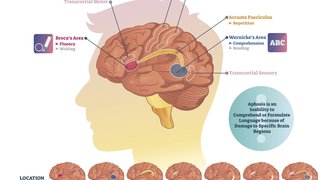
Getting better after a stroke is a marathon, not a sprint. Thanks to years of research, we know some of the steps that can help stroke patients on the road to recovery.
As a specialist in neurological rehabilitation at UT Southwestern here in Dallas, I often share this reminder with stroke patients and their families. You’ll find many resources to help you understand a stroke. But the bottom line is, stroke recovery is going to take time.
What happens during a stroke
Strokes are caused by a sudden interruption in blood flow to the brain. There are two types:
- Ischemic – Caused by a blocked blood vessel or clot.
- Hemorrhagic – The result of a blood vessel rupturing in the brain.
When blood can’t get to a part of the brain, the oxygen and glucose in the blood cannot feed those neurons. These cells begin to starve and can die very quickly if no action is taken.
The impact of a stroke can range from mild to severe. This depends on a number of factors – including the magnitude of the stroke and where the stroke occurs in the brain.
Stroke rehabilitation and therapy
The first step in stroke treatment happens when the patient has been admitted to a hospital. Immediate treatment can sometimes reverse at least some of their effects. Once stroke patients are stabilized (usually within two to three days), they are transferred to a rehabilitation unit to begin physical therapy. At this point, patients still may have problems moving their arms or legs, problems speaking or understanding language (aphasia), difficulty swallowing (dysphagia), or may even have trouble recognizing one side of their bodies.
At UT Southwestern, several therapists are involved in the care and rehabilitation of stroke patient, including:
- Physiatrist – This doctor will complete a full medical evaluation on the patient and measure progress toward goals.
- Rehab nurse – Evaluates the patient’s safety and provides information about the patient’s medications.
- Physical therapist – Evaluates how well the patient moves, including walking and getting in and out of bed and works toward improvement.
- Occupational therapist – Evaluates how well the patient can take care of himself or herself, such as getting dressed or eating and teaches new skills.
- Speech therapist – Evaluates the communication of the patient and how well he or she is swallowing food and water and uses methods to improve talking and eating.
Every day, the rehab patient meets with these therapists. Goals are set to determine when it’s safe for the patient to return home.
Stroke events are very individual. As a result, rehabilitation needs to be tailored to each patient’s overall health and our ability to support recovery. For example, if there are steps into a patient’s home, therapists will work with the patient on stair-climbing.
Some of the rehabilitation process depends on exercise. Through years of research, we know that enriching the environment around a stroke patient will help the patient’s brain regenerate faster. Specifically, exercise helps retrain brain cells as they are regenerating. When the patient exercises, lots of messages are sent to their brain to help it understand how to recover movement, communication skills, and other abilities. We can use advanced ways of helping this, such as electrical stimulation and specialized walking equipment.
How to help when stroke affects your family
Family support is very helpful during recovery from a stroke. A few simple things can make the process smoother, including:
- Meeting the rehab team at the beginning of the rehabilitation process, to go over the situation and what to expect going forward. Any changes that will need to be made at the patient’s home are discussed. If someone has trouble walking, for example, therapists may recommend removing throw rugs.
- Keeping a journal in the patient’s room. This way anyone can write down their observations, including staff and visitors. Doctors can leave a note for family members in case they don’t connect at the same time.
- Attending a therapy session with the patient to learn about the recovery process. It’s important for family members to know what they can do to help.
Family members need to remember to take care of themselves, too. Patients will need their support when they return home. It also may be helpful to educate yourself on how to prevent strokes in other family members.
Recovery from a stroke can be a lengthy, challenging process. Knowing what to expect and how to offer the best support can help everyone involved.










